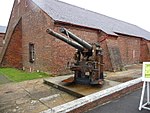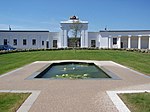Priddy's Hard
Ammunition dumps in EnglandGosportGovernment munitions production in the United KingdomTourist attractions in HampshireUse British English from October 2019

Priddy's Hard is a former military installation in Gosport, England named for the original landowner and the firm beach found there. The site originated as a 1750s fort, and then became an armaments depot for Royal Navy and British Army weapons, explosives and other stores. The site was decommissioned in 1988, after over two hundred years of operation, with part now being developed for housing and an area retained as a museum.
Excerpt from the Wikipedia article Priddy's Hard (License: CC BY-SA 3.0, Authors, Images).Priddy's Hard
Heritage Way,
Geographical coordinates (GPS) Address Nearby Places Show on map
Geographical coordinates (GPS)
| Latitude | Longitude |
|---|---|
| N 50.806666666667 ° | E -1.1255555555556 ° |
Address
Explosion! Museum of Naval Firepower
Heritage Way
PO12 4WF , Priddy's Hard
England, United Kingdom
Open on Google Maps











